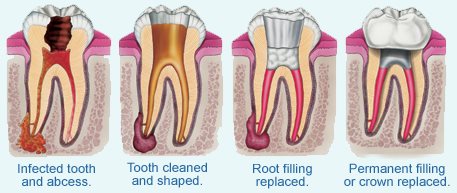Root Canal Therapy in Appleton, WI
Contact our office for full root canal treatment today.
What is Root Canal Therapy?
Root canal therapy is needed when the nerve of a tooth is affected by decay or infection. In order to save the tooth, the pulp (the living tissue inside the tooth), the nerve, bacteria, and any decay are removed and the resulting space is filled with special, medicated dental materials, which restore the tooth to its full function.
A root canal is the treatment of choice to save a tooth that otherwise would die and have to be removed. Many patients believe that removing a painful tooth is the solution, but they may not realize that extracting (pulling) a tooth will ultimately be more costly (because of the need to be replaced with either a bridge, implant, or partial denture) and can cause significant problems for adjacent teeth and gums. Root canal treatment is highly successful and usually lasts a lifetime. Occasionally, a tooth will have to be retreated due to new infections.
Schedule Your Dental Appointment
Reasons for Root Canal Therapy
- Decay has reached the tooth pulp (the living tissue inside the tooth).
- Infection or an abscess have developed inside the tooth or at the root tip.
- Injury or trauma to the tooth.
What Does Root Canal Therapy Involve?
A root canal procedure requires one or more appointments and can be performed by a dentist or endodontist (a root canal specialist). It usually follows the following steps:
- Anesthetic is used to “numb” the affected area.
- While the tooth is numb, a rubber dam (a sheet of rubber) will be placed around the tooth to keep it dry and free of saliva.
- An access opening is made on top of the tooth.
- A series of root canal files are placed into the opening, one at a time, removing the pulp, nerve tissue, and bacteria, and subsequently thoroughly cleansing the inside root surfaces.
- If tooth decay is present, it will also be removed with special dental instruments.
- At the next appointment, usually a week later, the roots and the inside cavity of the tooth will be filled and sealed with special dental materials. Most of the time, this appointment can be combined within the first appointment. It all depends on the degree of infection.
- Once the root canal treatment is complete, a filling will be placed to cover the opening on top of the tooth.
- In addition, all teeth that have root canal treatment should have a crown (cap) placed. Because root canaled teeth are extremely brittle, this will protect the tooth and prevent it from breaking, and restore it to its full function.
After treatment, your tooth may still be sensitive, but this will subside as the inflammation diminishes and the tooth has healed. This can actually take a few weeks, and in rare occasions, several months. You will be given care instructions after each appointment. Good oral hygiene practices and regular dental visits will aid in the life of your root canal treatment.

